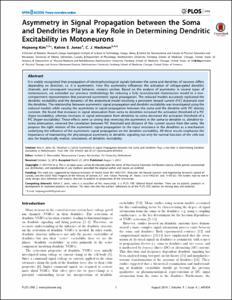Asymmetry in Signal Propagation between the Soma and Dendrites Plays a Key Role in Determining Dendritic Excitability in Motoneurons
- Title
- Asymmetry in Signal Propagation between the Soma and Dendrites Plays a Key Role in Determining Dendritic Excitability in Motoneurons
- Author(s)
- Kim, Hojeong ; Jones, Kelvin E. ; Heckman, C. J.
- Issued Date
- 2014-08
- Citation
- PLoS ONE, v.9, no.8
- Type
- Article
- Keywords
- PERSISTENT INWARD CURRENTS ; CHRONIC SPINAL RATS ; IN-VIVO ; ELECTRICAL-PROPERTIES ; ALPHA-MOTONEURONS ; PYRAMIDAL NEURONS ; LUMBAR MOTONEURONS ; PLATEAU POTENTIALS ; CALCIUM-CHANNELS ; FIRING PATTERN
- ISSN
- 1932-6203
- Abstract
- It is widely recognized that propagation of electrophysiological signals between the soma and dendrites of neurons differs depending on direction, i.e. it is asymmetric. How this asymmetry influences the activation of voltage-gated dendritic channels, and consequent neuronal behavior, remains unclear. Based on the analysis of asymmetry in several types of motoneurons, we extended our previous methodology for reducing a fully reconstructed motoneuron model to a two-compartment representation that preserved asymmetric signal propagation. The reduced models accurately replicated the dendritic excitability and the dynamics of the anatomical model involving a persistent inward current (PIC) dispersed over the dendrites. The relationship between asymmetric signal propagation and dendritic excitability was investigated using the reduced models while varying the asymmetry in signal propagation between the soma and the dendrite with PIC density constant. We found that increases in signal attenuation from soma to dendrites increased the activation threshold of a PIC (hypo-excitability), whereas increases in signal attenuation from dendrites to soma decreased the activation threshold of a PIC (hyper-excitability). These effects were so strong that reversing the asymmetry in the soma-to-dendrite vs. dendrite-to-soma attenuation, reversed the correlation between PIC threshold and distance of this current source from the soma. We propose the tight relation of the asymmetric signal propagation to the input resistance in the dendrites as a mechanism underlying the influence of the asymmetric signal propagation on the dendritic excitability. All these results emphasize the importance of maintaining the physiological asymmetry in dendritic signaling not only for normal function of the cells but also for biophysically realistic simulations of dendritic excitability. © 2014 Kim et al.
- Publisher
- Public Library of Science
- Related Researcher
-
-
Kim, Hojeong 바이오메디컬연구부
- Research Interests Movement science; Neuromuscular physiology; Computational Medicine; Neural interface
-
- Files in This Item:
-

10.1371_journal.pone.0095454.pdf
기타 데이터 / 1.61 MB / Adobe PDF download
- Appears in Collections:
- Division of Biotechnology 1. Journal Articles



